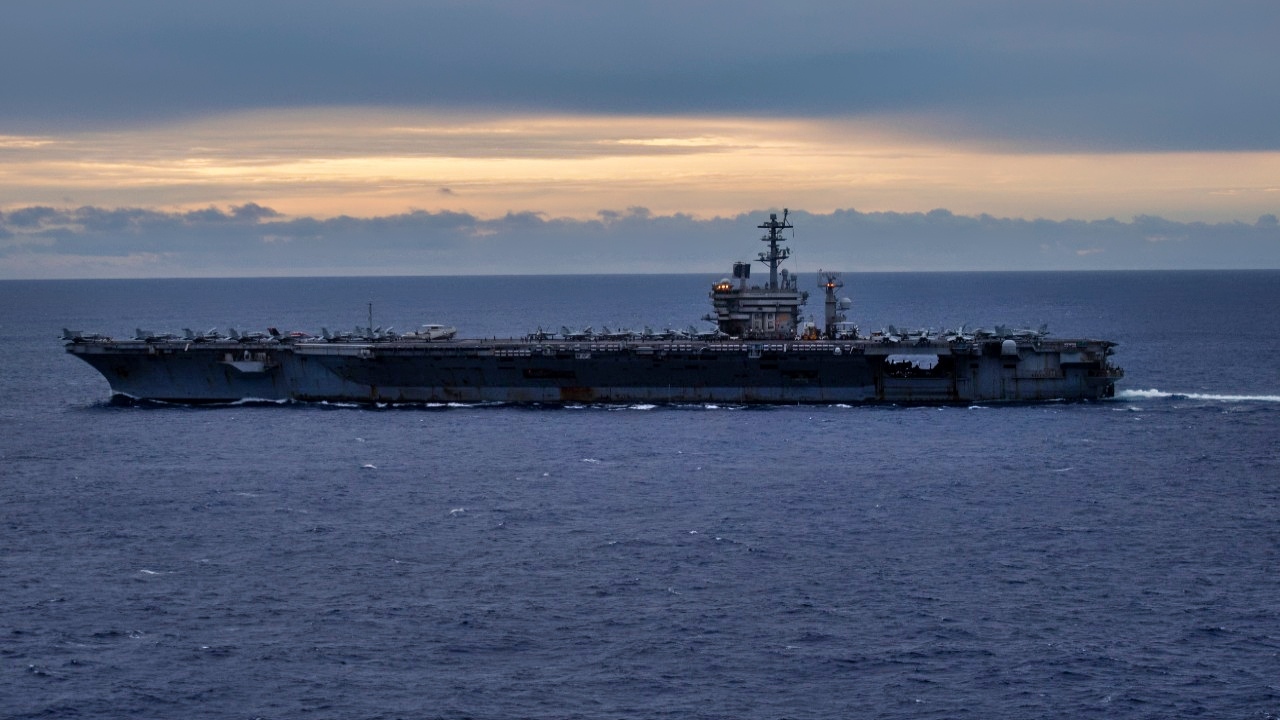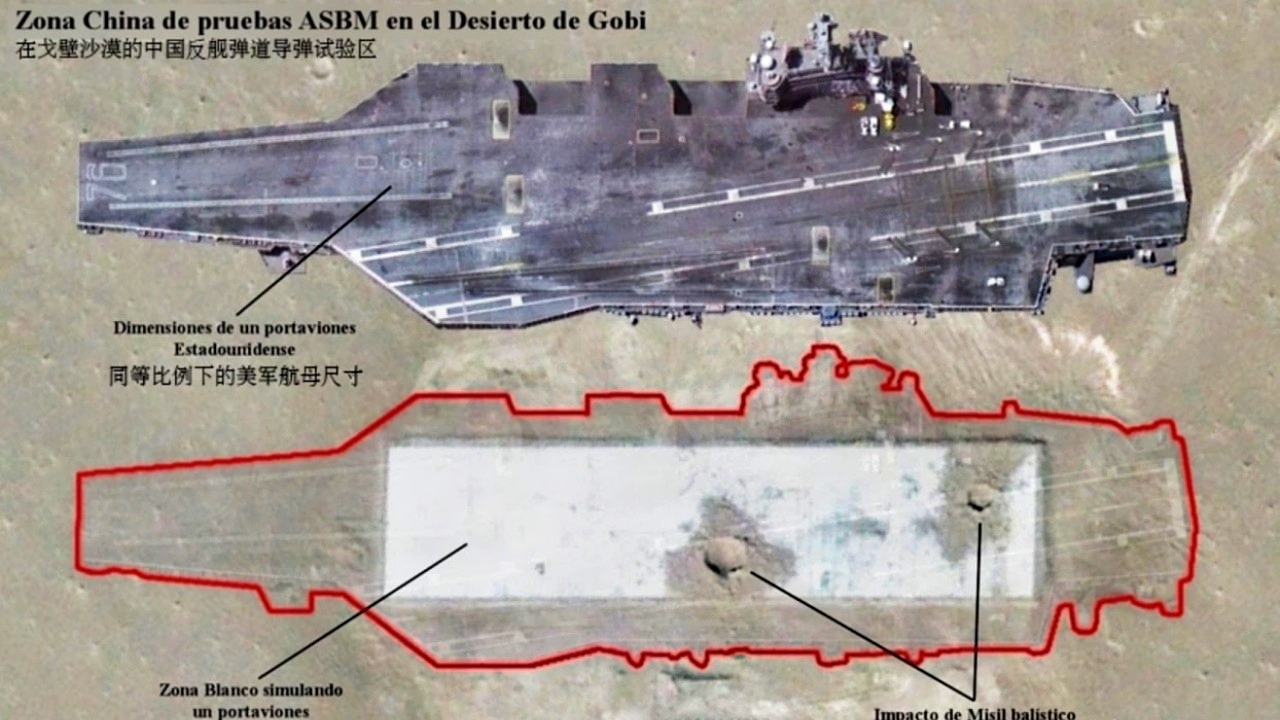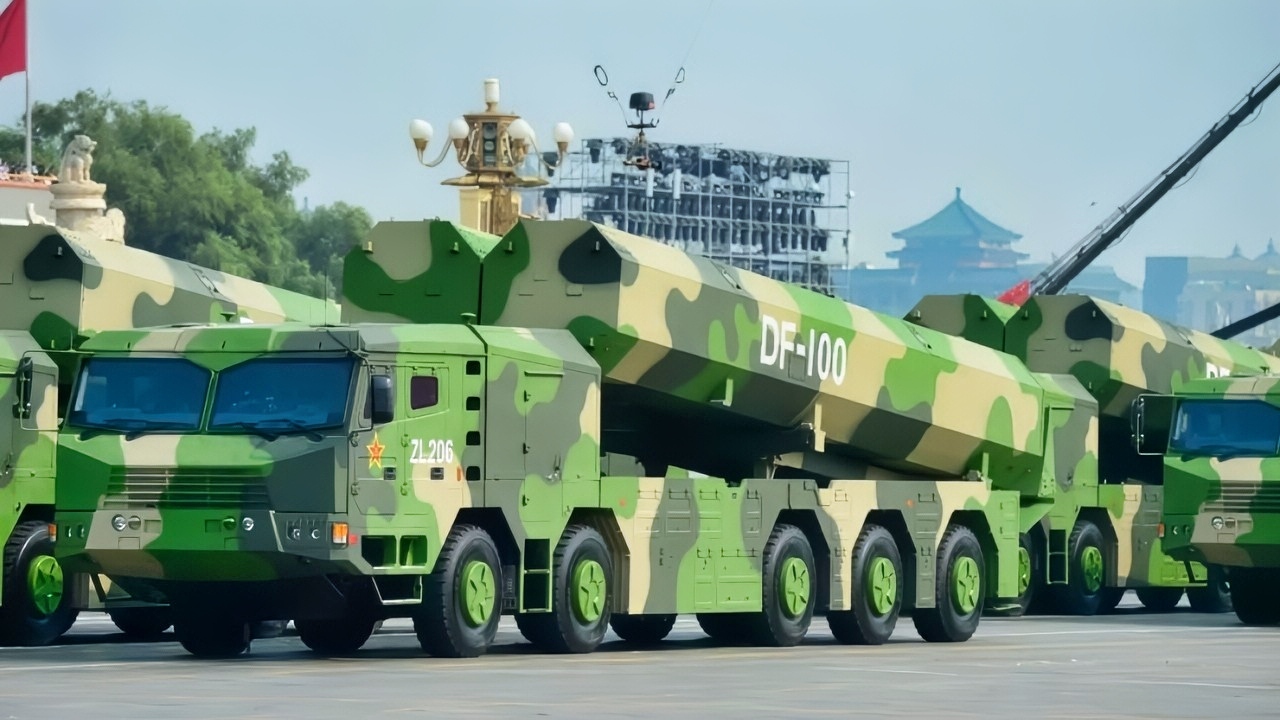Key Points and Summary – This analysis argues that to counter China’s “carrier-killer” missiles, the U.S. Navy must “flip the script” and stop fighting on Beijing’s terms.
-Instead of relying on vulnerable carrier groups, the U.S. must restore deterrence through a distributed, layered strategy.

(May 30, 2023) The aircraft carrier USS Nimitz (CVN 68) steams through the Pacific Ocean. Nimitz is in U.S. 7th Fleet conducting routine operations. 7th Fleet is the U.S. Navy’s largest forward-deployed numbered fleet, and routinely interacts and operates with allies and partners in preserving a free and open Indo-Pacific region. (U.S. Navy photo by Mass Communication Specialist 3rd Class Kenneth Lagadi)
-This includes upgrading defensive radars (SPY-6), embracing offensive “affordable mass” with new weapons like QUICKSINK, prioritizing submarines and unmanned systems, and deeply integrating allies by forward-basing mobile missile batteries to create a “no-go zone.”
The U.S. Navy Has a Problem: Lots of Chinese Missiles in a War Aimed at Aircraft Carriers and More
If and when the next war comes over Taiwan or the South China Sea, the U.S. Navy must not fight on China’s terms.
Beijing’s arsenal of long-range, precision-guided missiles has produced a dangerous asymmetry. America’s ships, aircraft carriers especially, and aircraft are at risk of being harried, mauled, and even destroyed at will. This keeps U.S. forces at arm’s length and degrades the credibility of American power in Asia.
To win—and, more important, to help prevent such a war from ever breaking out—the Navy must flip the script: China must be made to fight on the Navy’s terms, not the other way around. This is not about provoking war. It is about restoring deterrence and preserving a stable balance of power in the Indo-Pacific.
The Navy must embrace a layered strategy of technology, tactics, and diplomacy that makes China think twice before pulling the trigger—and if it does, to ensure that Beijing will regret it. The goal of all these changes is simple: to strengthen deterrence and thereby preserve a stable balance of power in the Indo-Pacific.

DF-26 China Missile Attack on Fake Aircraft Carrier Cut Out. Image Credit: Chinese Weibo Screenshot.
China vs. the U.S. Navy: What To Do
First, on the technological front: the United States must field an effective defensive shield against Chinese anti-ship and land-attack missiles.
Recent upgrades to the AN/SPY-6(V)4 radar on U.S. destroyers are an encouraging development, and their ability to track hypersonic, cruise, and surface threats at once is a much-needed capability. The Navy should prioritize installation of this radar on the surface fleet and pair it with an improved interceptor suite of SM-6 variants and possibly ship-launched Patriot-class PAC-3 MSE. Washington must also invest urgently in hard-kill counter-hypersonic defenses. The rule of thumb should be early detection and multi-vector interception.
Second, the United States must embrace “affordable mass” in its offensive arsenal and use it to shape the battlespace. Upscaling efforts like the “QUICKSINK” ship-lilling smart bomb program, which is now in testing and slated for limited deployment over the next year, will enable the United States to swarm Chinese defenses and threaten their surface fleet with large numbers of lower-cost precision weapons.
The Navy should use this capacity to disperse and convert lower-value platforms and allied bases into “distributed strike nodes”—each capable of launching multiple weapons and thereby forcing the Chinese to expend missiles or risk losing ships. The effect: Chinese missile salvos become more costly and less decisive, restoring a measure of deterrence through uncertainty.
Tactically, the Navy must downplay the traditional carrier-battle-group centerpiece and double down on distributed lethality and the undersea advantage. Chinese A2/AD systems are optimized to detect and attack large surface formations; submarines, unmanned surface and subsurface vessels, and mobile missile bastions disrupt that calculus.
Intelligence analysis indicates that U.S. surface forces will be at risk in a Taiwan scenario—but subsurface dominance offers better prospects for surface-strike and anti-surface denial.
The Navy Has Options
The Navy should use submarines (both attack and missile-armed), unmanned systems to track Chinese missile batteries and command-and-control nodes, and conduct “shoot-and-scoot” operations so that Chinese targeting is deferred or misdirected. Every evasive maneuver buys time, every lost target erodes Beijing’s confidence in escalation.

DF-100 Missiles: X Screengrab.
Strategically, the Navy must integrate its war-fighting potential with a broader campaign of proactive allied basing, logistics resilience, and layered forward presence.
Mobile coastal-defense missile units and anti-ship batteries in the Philippines, Malaysia, Taiwan, and other first-island-chain states can create a de facto no-go zone for China. Systems such as the Navy-Marine Expeditionary Ship Interdiction System (NMESIS), which are still in development, should be deployed in allied exercises to amplify deterrence by creating a multi-axis threat environment.
Forward-deployed forces force China to account for challenges from multiple directions, potentially detracting from its missile-centric defensive “bubble.” It also has the virtue of drawing the U.S. Navy out of a purely reactive posture.
Diplomatically, the Navy’s war-fighting potential is only as strong as its alliances and its regional interoperability. The United States should deepen missile-warning and sensor-sharing linkages with Australia, Japan, South Korea, and Southeast Asian littorals, ensure common logistics lines, and expand multilateral training that replicates Chinese missile salvos.
China’s Big Plan in 4 Words: Lots of Missile Attacks
Because missile saturation is a game of mass and timing, realistic training conditions allow China’s numeric advantage to erode. Moreover, the United States must also conduct persistent peacetime operations in the first island chain to deny China the unchallenged ability to calibrate its launch zones and vectors at will. Sustained presence is the bedrock of credible deterrence.
Finally, all of the above is for naught if the Navy does not also embed strategic deterrence into its design. Chinese planners must believe that a strike against U.S. naval or coalition forces, or the logistic bases that support them, will not simply knock out one ship or command node but trigger cascading losses that include their own launchers, logistical bases, and maritime access.
This deterrence depends not only on visible capabilities—upgraded radars, a new, distributed-strike architecture—but also on transparent commitment to that architecture: forward basing, cooperative training, and sustained missile production that is now being ramped up across the industrial base. If China has reason to doubt that a missile salvo will guarantee victory, it will hesitate. Hesitation is deterrence in action.
The U.S. Navy Can Develop a Strategy to Take on China’s Missiles
The U.S. Navy can upend China’s missile advantage, not by out-building China in sheer numbers, but by out-thinking it: by leveraging advanced sensors and interceptors, dispersing strike power, exploiting the submarine and unmanned advantage, forward-deploying allies, and strengthening regional networks of deterrence.
The coming contest over Taiwan and the South China Sea will not be won by who fires first. It will be decided by which side convinces the other that firing at all would shatter the stability both sides ultimately need.
About the Author: Dr. Andrew Latham
Andrew Latham is a non-resident fellow at Defense Priorities and a professor of international relations and political theory at Macalester College in Saint Paul, MN. You can follow him on X: @aakatham. He writes a daily column for the National Security Journal.
More Military
The Los Angeles-Class Submarine Has a Message for the U.S. Navy
‘Never See It Coming’: A First Look at the NGAD F-47’s Bomber-Like Stealth
The Real Reason U.S. Military Recruiting Numbers Are Surging
The Midway-Class Aircraft Carrier Has a Message for Every Navy on Earth
The YF-23 Black Widow II Stealth Fighter Still Haunts the U.S. Air Force










